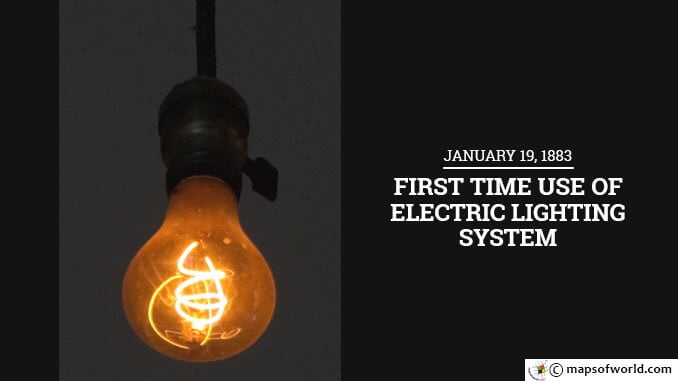On January 19, 1883, the overhead electric lighting system designed by Thomas Edison for Roselle, New Jersey, was used for the first time, making it to be the first city in the world to be lit up by electricity. Thomas Alva Edison was born on February 11, 1847, in Milan Ohio. Despite his humble beginnings, a love of science and technology led Edison to become one of the most accomplished inventors of the world. By the time he died in 1931 in West Orange, New Jersey, Edison had given the world a number of inventions that would change the lives of generations to come – the electric light bulb, telegraph, alkaline storage batteries, phonograph, and kinetograph (a motion picture camera). Not only did Edison invent these, he also presented plans for the practical and mass application of his scientific inquiries thereby leaving an indelible mark in the history of mankind. He held 1,093 US patents in his name and many more in Europe. Starting off as a telegraph operator at the age of 15, Edison’s appetite for innovation and inventions led him to set up the earliest industrial research and mass-scale production laboratory at Menlo Park. The phonograph and the quadruplex telegraph brought Edison success, money, and fame. Through the 1870s, Edison worked closely to produce a commercially sustainable version of the incandescent light as worked upon by scientists such as Alessandro Volta, Henry Woodward and Mathew Evans. All previous attempts including those of Humphry Davy, James Bowman Lindsay, Moses G. Farmer, and William E. Sawyer were impractical. Edison strived to achieve a model that would combine a long life and regulated electricity consumption with a practical cost when produced on a large scale. On November 4, 1879, Edison filed to acquire a US patent for an electric lamp using “a carbon filament or strip coiled and connected to platina contact wires”. The patent came through in January 1880 but by the time, Edison had put in hours of tests and research into perfecting the electric bulb. The invention changed the way the world lived and functioned. It opened the doors for the development of a number of other inventions that now make up the modern world. Now keen on finding a way to distribute electricity and power up and light entire cities, Edison set up the Edison Illuminating Company—the first ever investor-owned electric utility in the world. The company later came to be known as the General Electric Corporation. The company was set up in in New York City and was backed by a number of a financiers including J. P. Morgan. It soon meant that the Edison Illuminating Company became responsible for creating electricity systems that could power cities up. Roselle in New Jersey was up first. Overhead wires were put in place by early 1883, creating an intricate network to conduct electricity through the city. A central steam-driven generating station would supply the necessary electricity. The generator located in the north-east corner of Locust Street and West First Avenue sent power through the city. On January 19, 1883, the city made history when the 150 streetlights, 40 houses, a store, and the central railway depot started to glow in the light of an electric bulb. Work continued in Roselle for over three months. The First Presbyterian Church of Roselle became the first church in history to be lit by an electric light bulb in April that year when it installed a 30-bulb “electrolier”. The electrolier is still hung in the church to mark the significance of the event. Edison often faced criticism over the origin of many of his patents. Other inventors such as Nikola Tesla criticized him for jumping headlong into tests and labor instead of using scientific calculations to arrive at his conclusions. Despite all the criticism faced by Edison, he remains a popular figure in the world of science and innovations. He may not have invented all that he patented but his constant endeavor to improvise and produce utilities of mass-scale use certainly earned him the epithet “Wizard of Menlo Park”. To this day, Thomas Edison continues to remain an inspiration for scientists and people who seek to pursue their dreams. “Opportunity is missed by most people because it is dressed in overalls and looks like work.” – Thomas Edison You may also like : January 19 1915 – The Germans Bomb Great Yarmouth and King’s Lynn, the First Civilian Targets in History
January 19 1883 – First Time Use Of Electric Lighting System
On January 19, 1883, the overhead electric lighting system designed by Thomas Edison for Roselle, New Jersey, was used for the first time, making it to be the first city…
1K
